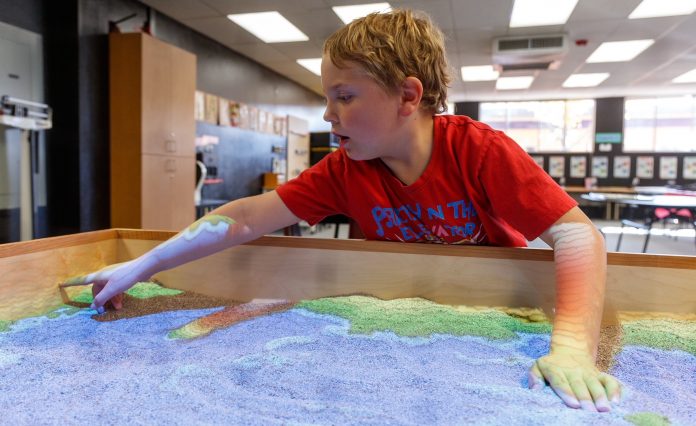Eight-year-old Landon ran into the Science Vortex, a room in a repurposed building of the old Cottonwood Elementary School campus, excited to be allowed in. He rushed over to his favorite of the toys that filled the space, a pneumatic pump attached to a foam rocket.
Landon pushed hard on the pump three or four times and then pressed the button to let the rocket fly. It soared across the room to Landon’s glee, past a sign on the wall explaining the concepts of lift and aerodynamics. Landon rushed next to a table full of simple circuitry and exclaimed, “We’re going to make a light.”
Throughout the large room that contains the new Science Vortex, there are dozens of other activities that make kids shout with glee while also giving them opportunities to learn about science and technology. Students create a short path for Ozobots, little motorized robots that can read simple programmed commands, teaching the basic rudiments of coding. K’Nex, Lego and other building blocks allow kids to experiment with their creativity by building structures or simple machines, while a holographic display over a sandbox creates a topographic map to teach kids rudimentary geology and the way that rainwater flows through mountainous terrain.
Laurie Altringer, the program’s president and lead educator, was a math teacher in public schools before she began Science Vortex, feeling that she could better teach young kids about science, technology, engineering and math — STEM subjects — through this kind of experiential education than through a normal classroom.
“As a teacher, I felt limited with time and felt the need to stick to the standards, sometimes at the cost of not giving kids enough time to persevere,” Altringer said. “The objective of this center is to improve kids’ 21st century skills — perseverance, critical thinking, communication. It’s not meant to replace schools in any way, just enhance the skills that schools are meant to encourage under their learners.”
The nonprofit — they lease the building from the Cottonwood-Oak Creek School District, which has numerous leftover buildings on the former CES campus — opened this summer with a summer camp program, before transitioning to a schedule that fits in with the local school districts. Mondays at 10 a.m. feature a free Little Learners program for children ages 2 to 5, through a grant from the city of Cottonwood, while Thursdays have a free family program sponsored by the Rosenbluth Family Foundation. Throughout the rest of the week, the space is open for private parties, as well as field trips from local classrooms, some of which can walk there from the Cottonwood Community School campus.
“The layout of the center is so engaging that, as an adult, you immediately want to jump right in and get involved with the activities,” said Don Groves, a former school counselor and principal, and member of the Science Vortex board. “With public school education funding being spread so thinly this past decade, schools reluctantly were forced to reduce the breath and depth of their educational programs. Fortunately, with the vision and creativity of founder and director Laurie Altringer, the Verde Valley has an educational resource in the Science Vortex where children can explore science, technology, engineering, mathematics, technology and art beyond the traditional classroom.”
Altringer hopes that teachers can take advantage of trips there as a chance to let students take a break from classroom instruction while also learning things.
“I had a field trip here the other day, and there were kids who were building a Rube Goldberg machine,” Altringer said. “One boy — it took him about five minutes to figure out how to make the ball roll faster by making [the slope] steeper. He didn’t know that. He came here probably as an 8- year-old. Giving kids those opportunities that aren’t in the box of learning standards is important. And again, that perseverance, just digging in until you figure it out.”
Altringer likes using the acronym FAIL, not for the disappointment often associated with failure, but to mean “First Attempt In Learning,” encouraging students to try again after missing on the first attempt, and working until they figure it out.
“They’re building prior experiences here, so then when they learn these in their science classes, if they’re having fun here and they associate it with fun, they’re more likely to engage in their own classroom,” Altringer said. “It’s introducing the idea in a hands-on fun way, so that later they can really dive in and, then again really have the perseverance to dig deeper.”



